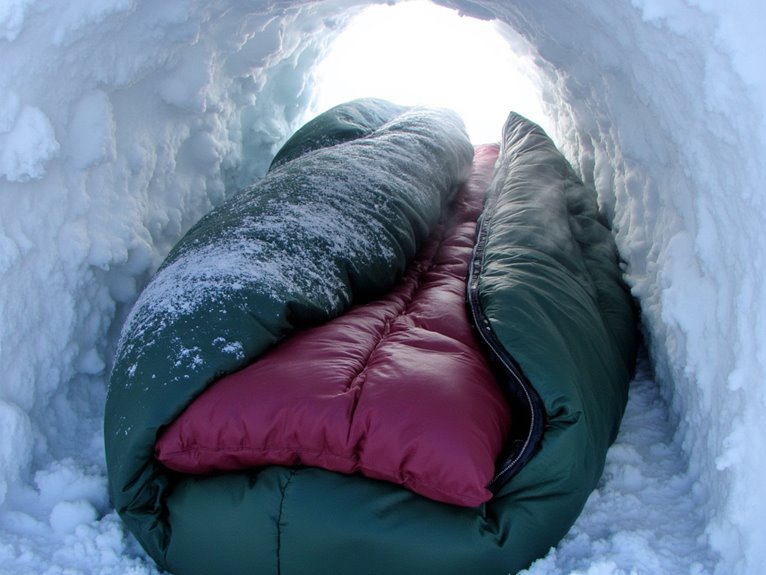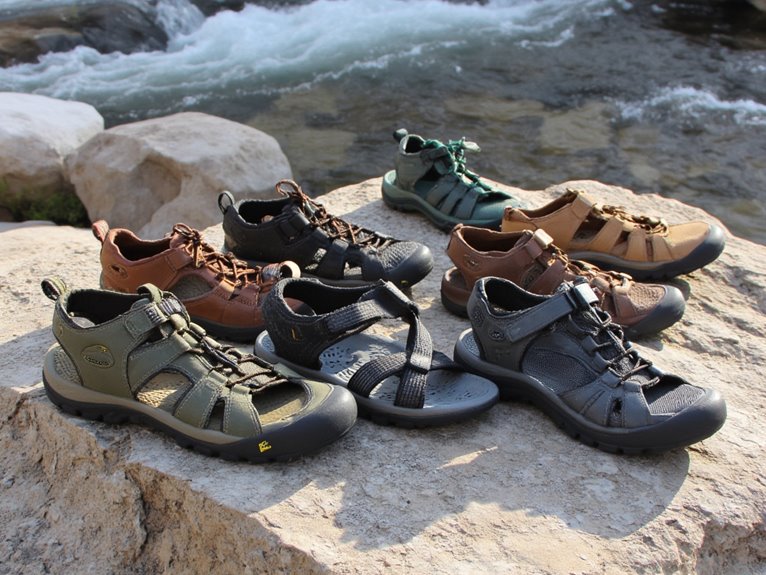How to Layer Sleeping Bags or Use Overbags for Extreme Cold
You’ll need to layer two sleeping systems when temperatures drop below -10°F, starting with your primary bag rated 15-20°F above expected conditions, then adding an overbag that extends warmth by 15-30°F. Place the lighter bag inside the heavier one, ensuring both maintain full loft without compression. Use synthetic fills for outer layers since they retain 80% insulation when wet, while down works best for inner bags. Proper positioning prevents thermal bridging and air gaps that compromise your entire system’s effectiveness.
We are supported by our audience. When you purchase through links on our site, we may earn an affiliate commission, at no extra cost for you. Learn more. Last update on 13th November 2025 / Images from Amazon Product Advertising API.
Notable Insights
- Use an overbag over your primary sleeping bag to extend temperature rating by 15-30°F in extreme cold conditions.
- Layer with moisture-wicking base layers next to skin, then primary bag with full loft, topped by snug-fitting overbag.
- Ensure overbag compatibility with your sleeping bag dimensions and secure all openings to prevent heat-robbing drafts.
- Choose breathable overbag materials under 2 pounds to prevent moisture buildup while maintaining backpacking practicality.
- Combine with insulated sleep pad (4-5 inches thick) and consider adding draft collar for maximum insulation effectiveness.
Understanding Temperature Ratings and Base Layer Requirements
When selecting sleeping bags for extreme cold conditions, you’ll need to understand standardized temperature rating systems before making any gear decisions.
EN 13537 and ISO 23537 provide standardized temperature ratings that allow direct comparison across manufacturers. These systems establish three key measurements: Comfort Rating for average cold sleepers, Limit Rating for warm sleepers who can tolerate lower temperatures without shivering, and Extreme Rating for survival conditions.
Your base layers directly impact sleeping bag performance in extreme conditions. Merino wool and synthetic fabrics offer superior moisture-wicking properties compared to cotton materials.
Thicker base layers provide additional insulation through trapped air pockets. Layering multiple base layers creates enhanced warmth retention. However, real-world performance varies based on individual metabolism, clothing choices, and environmental factors beyond standardized laboratory testing conditions.
Down insulation offers exceptional thermal efficiency and superior compressibility, making it ideal for extreme cold conditions where weight and packability are crucial considerations.
Choosing the Right Materials: Down Vs Synthetic Fill for Layering
Sleeping bag material selection becomes your next critical decision after determining temperature ratings and base layer configurations.
Down warmth delivers superior temperature performance per ounce, making it ideal for weight-conscious layering systems.
Synthetic durability provides consistent insulation when exposed to moisture and requires less maintenance than down alternatives.
Your material choice impacts four key performance factors:
- Weight efficiency – Down offers 20-30% better warmth-to-weight ratios than synthetic fills.
- Moisture resistance – Synthetic fills retain 80% insulation when wet versus down’s 20% retention.
- Compressibility – Down compresses to half the packed size of equivalent synthetic insulation.
- Cost considerations – Synthetic options cost 40-60% less than comparable down products.
Consider combining both materials: synthetic base layers for moisture management with down outer bags for maximum thermal efficiency in extreme conditions.
High-quality down bags can last 10-50 years with proper care, while synthetic bags typically last 3-5 years due to rapid degradation.
Overbag Selection and Placement Strategies
Although your primary sleeping bag provides the foundation for warmth, an overbag transforms your sleep system into a fortress against extreme cold by adding an essential outer layer of protection.
Essential overbag features include temperature ratings that extend your bag’s range by 15-30°F, breathable materials that prevent moisture buildup, and weights under 2 pounds for backpacking efficiency.
You’ll need proper overbag compatibility with your existing bag’s dimensions and style—mummy bags require mummy overbags, while rectangular designs offer more flexibility.
Position the overbag as your outer layer, never inside your sleeping bag. Confirm seams are fully sealed and adjust the fit to eliminate air gaps.
Your overbag should accommodate your sleeping bag’s loft without compression, maintaining insulation effectiveness while blocking cold air infiltration and external moisture.
Consider that synthetic fiber fills in overbags provide reliable insulation that performs well even when exposed to moisture, making them ideal for layering systems in extreme conditions.
Essential Layering Techniques and Order of Arrangement
Beyond selecting the right overbag, your success in extreme cold depends entirely on how you arrange and sequence each component of your sleep system.
Proper base layering with moisture-wicking materials creates the foundation, while draft prevention between layers maintains thermal efficiency. Each component must work together to trap warm air while managing moisture buildup.
- Start with a moisture-wicking base layer directly against your skin using merino wool or synthetic fabrics
- Place your primary sleeping bag first, ensuring it’s fully lofted and properly positioned
- Add the overbag or secondary layer, maintaining snug fits to eliminate air gaps
- Secure all openings and zippers to prevent drafts from compromising the thermal barrier between layers
For extreme cold conditions below the comfort rating of your primary bag, consider adding a draft collar between layers to enhance insulation and prevent heat loss at critical junction points.
This systematic approach maximizes insulation while preventing heat loss through convection and conduction.
Equipment Accessories and Testing Your Cold Weather Setup
Three critical accessories can make or break your extreme cold sleeping system: overbags, liners, and insulated sleep pads. Overbags provide waterproof protection while preventing compressive heat loss. Liners add 5-10°F warmth and keep your bag clean. Full-length insulated pads prevent ground heat transfer. For extreme cold conditions, prioritize pads with 4-5 inches of thickness to maximize insulation from frozen ground and provide crucial support for comfort during long winter nights.
| Accessory | Primary Function | Performance Gain |
|---|---|---|
| Overbag | Wind/moisture protection | Extends bag life |
| Liner | Added insulation | 5-10°F warmth boost |
| Sleep Pad | Ground insulation | Prevents heat loss |
Testing strategies should include controlled environment trials before field use. Monitor moisture buildup and assess component integration. Regular accessory maintenance involves inspecting seams, checking inflation systems, and cleaning liners. Test your complete system’s thermal performance under realistic conditions, adjusting layering order based on results.




